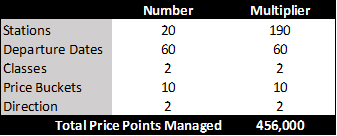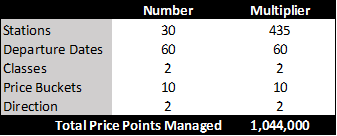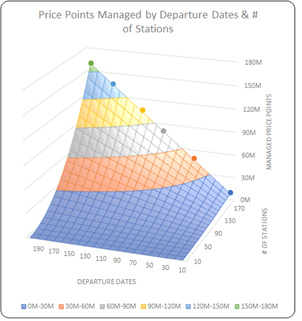RARS2 is Coming: How to Integrate Successfully and Leverage the New Capabilities
For the United Kingdom (UK) passenger rail industry, transitioning to the new RARS2 (Rail Availability & Reservation Service) system from the current National Reservations System (NRS) is both exciting and complex.
RARS2 is exciting because of the increased capability and revenue opportunities it will offer to operators that integrate successfully. It’s complex because moving to the new system is a massive undertaking that is replacing the core component of how the UK Rail system communicates with millions of customers each day.
Raising the stakes even higher, UK taxpayers are both the customers and the investors in this transition for every train operating company (TOC).
Clearly, it is critical for the industry as a whole and for TOCs individually that this transition goes well.
Transition to RARS2 Moves Ahead, Despite COVID Pandemic
The UK’s Rail Delivery Group (RDG) is coordinating this move on behalf of UK TOCs. Leading up to the COVID pandemic, the sense we got from TOC Revenue Management (RM) teams and from our involvement in the RARS2 testing was that there was a general level of confidence for achieving the system cutover per the plan.
As it has done to so many other plans, however, the COVID pandemic has impacted the RARS2 timelines, pushing back the rollout of the first tranche by eight weeks into the early fall. The rollout schedule has also been compressed into three tranches instead of four.
Yet, even with this delay, the RARS2 initiative continues to move forward and remains a major focal point for UK TOCs for this year.
Three Challenges to a Successful RARS2 Transition
As we have spoken with different TOCs during their preparation for the RARS2 transition, the discussions have tended to come back to three primary challenges:
- Am I ready for the RARS2 “journey”-focused pricing versus the legacy leg-based approach?
- How will I use the real-time capabilities in RARS2 to generate more value for passengers?
- Is my Revenue Management System (RMS) ready to integrate to RARS2 and drive benefit for both myself and my customers?
The theme across these challenges is “uncertainty”. Change always creates uncertainty, because of the unknowns and because we’re forced out of our working comfort zone.
TOCs can, however, greatly improve the likelihood of a successful RARS2 outcome by executing against a detailed plan, leveraging trustworthy partners, and having tools that they trust. We’ve seen this formula work many times during challenging transitions, and we believe it holds true again for the TOCs’ move to RARS2—even during a global pandemic.
In this blog, we will discuss the three challenges and assess how TOC Revenue Management teams can prepare for a successful RARS2 integration that maximizes revenue by fully leveraging the RARS2 capabilities.
1. The Journey-Management Challenge: Is Your Company Ready?
One of the biggest changes brought by RARS2 is the move to management by journey allocation (“journey” is sometimes referred to as O/D, or origin and destination). RARS2 will now require RM teams to move to journey management.
Managing at the journey level will provide many opportunities for TOCs and customers; however, it also presents challenges to TOCs.
The Opportunities in Journey Management
For most customers, the journey level is precisely how they think about their travel: simply getting from point A to point B. Few travelers think of their trip as the accumulation of the legs in that journey. (I’m excluding those customers attuned to split-ticketing opportunities. More on that topic in another post.)
For many TOC RM teams, however, moving to management at the journey level will be a major shift in the way they think about Pricing and Revenue Management. That’s because most passenger-rail operators have traditionally managed their operations on a leg basis.
So, while it is different and a new challenge, managing fares at the journey level will focus the RM teams at the same level as their customers. This will be a win-win outcome.
The Challenges in Journey Management
The challenge of managing at the journey level is that price points now need to be managed for each journey. And those price points increase exponentially with the number of stations being managed within the network.
To put this into numbers, let’s look at the tables below, which highlight the total number of price points managed in networks of varying complexities:


As you can quickly see, merely changing from 20 stations to 30 stations on a network more than doubled the number of price points to manage. And this would be just one of multiple networks for a TOC.
And to get a more comprehensive perspective, let’s look in three dimensions.

Journey Management and Mathematical Optimization
The human mind cannot effectively work with this number of complex pricing decisions, but a computer can. However, for the computer to truly analyze and solve a problem this size, it needs to perform a true mathematical optimization that calculates allocations for each price point. That’s as opposed to merely applying a general set of business rules, whose order of priority must be continually maintained and applied across a large set of journeys.
True mathematical optimization allows the system to automatically assess different tradeoffs within a specific train departure, adjacent train departures, differing journey lengths (fast vs. slow trains), and other departures within the daypart. As a result, TOC RM teams are fully empowered to make revenue-maximizing decisions.
On the other hand, business rules will follow the prescribed hierarchy and only apply in explicitly defined scenarios.
This is not to say that business rules have no place in the overall scheme of a modern RMS. To the contrary, business rules are necessary for implementing the standard business practices identified by the TOC. Those business practices often include putting guardrails in place, such as “close all price buckets below ‘x’ at a certain number of days prior to departure”.
And yet, managing pricing decisions primarily by business rules simply cannot ensure that you are maximizing your revenue. Given the complexity illustrated in the tables and graph above, managing by business rules will, at best, only automate the legacy approach that RARS2 is urging you to abandon.
So, as you are transitioning to the new “journey-based” pricing world, you will need to have the right tools in place.
The right tools will empower you to manage every single one of your price-point allocations, which creates a win-win situation for you and your customers—without your TOC needing an army of revenue managers.
This all translates into better yields on your high-demand journeys for you, while being able to shift demand to less-crowded trains at a lower price for your customers.
2. The Real-Time Challenge: Not Just Faster, but Better, Too
Currently with NRS, it is an overnight process to:
- Send the daily bookings to the RMS,
- Execute the RMS processes and update the allocations, and
- Send the updated allocations back to the NRS.
However, in RARS2 there will be the capability to receive booking updates in real time. This will give the RMS and the RM teams the ability to react to significant demand changes during the same day, potentially avoiding spilled revenues that occur when customers can react faster to a new event than the system can.
For example, imagine a typical scenario in which a football match between two prominent teams is announced at 10:00 a.m. Demand for travel to the match will likely rise suddenly and dramatically.
Under NRS, a TOC’s RMS would not be aware of the rise in demand until the next day. By then, however, the capacity may have been consumed, or the majority of demand may have already passed. With RARS2, the RM team can know immediately and adjust their allocations via their RMS that very morning.
Yet, the RMS’s awareness of the rise in demand is only one factor to consider. Acting on the new demand information does not have to be a manual process.
RM teams should not have to always be monitoring their system. Next-generation RMSs can identify situations like the one outlined above as they occur and dynamically re-forecast / re-optimize the allocations to get allocation updates back to RARS2 as quickly as possible. In doing so, a next-generation RMS can minimize potential revenue spill.
Following dynamic re-forecasting / re-optimization, the RM team can decide if they need to further address the situation with their human intelligence. The key point here, however, is that it becomes their decision to do so, not a mandatory action they have to take.
The previous step—addressing the one journey that is now showing the greatly increased demand—might sound easy to handle. In the journey-pricing world, however, the network effects of one journey will cascade to other journeys. So, these real-time updates need to consider the overlapping journeys that are being impacted by this spike in demand and adjust automatically. Without considering these network effects, you run the risk of overselling to a lower-value journey or exposing yourself to split-ticketing risk.
3. The Integration Challenge: Is Your Revenue Management System Ready?
In the midst of the COVID crisis and all its disruptions, TOCs must keep their focus on the preparation and tasks for the RARS2 transition. And their RMS vendor’s preparedness and capabilities must also be validated. Why is this validation so important? Well, it breaks down to three main points:
- Your RMS sets the allocations, so it is controlling customer pricing and, therefore, your revenue.
- A properly functioning RMS will support your customers’ perceptions of your service by helping to control crowding, providing less expensive options, and reserving seats for last-minute travelers.
- Manual processes take time away from your RM team. So, if they are constantly updating rules, then they are managing a system, not your revenue and not your customers’ experiences.
In assessing preparedness for the transition, some of the questions for RMS vendors and legacy systems are obvious:
- What is the status of their RARS2 interfacing efforts? Will the interface be ready and tested when my tranche occurs?
- What has been your involvement in the process and discussions to date?
- What kinds of testing have you done (e.g., transactional, volume, etc.)?
- What type of support will be provided during the parallel run period between NRS and RARS2?
Other questions around capabilities get to the heart of your business: As a TOC, are you just interested in managing revenue, or are you interested in practicing Revenue Management?
- Has your RMS been built with RARS2 in mind?
- Will your RMS provide optimized journey allocations for all journeys?
- Has your RMS worked with real-time interfaces previously?
- Does the RMS forecast and optimization automatically occur when intra-day demand surges occur?
If any RM team cannot answer YES to all of these questions, then they will not be able to get the full benefit for themselves and their customers out of the RARS2 transition.
So, in taking a good hard look at your RMS, consider carefully whether it is setting you up to just get by, or if it is setting you up to truly succeed?
Next-Generation RMSs, Revenue Benefits, and the “New Normal”
This is an exciting and complex time. Decisions being made now will impact the future of the UK TOCs and their riders.
I commend the RDG team and all UK TOCs for continuing to move ahead during this COVID pandemic. They are focused on the future and making sure that they are positioned to succeed, even with the challenges currently being faced.
This period has been talked about as a time of change, both with the transition to RARS2 and the transition to the “new normal” as the COVID pandemic eases. We are entering a new era where yesterday’s rules are out the window and next-generation RMSs will be needed to adapt to the constantly evolving ebbs and flows of demand and ongoing COVID impacts.
With its powerful additional capabilities available to TOCs, RARS2 is one of those steps forward into this new era. To get the full benefits from RARS2, however, your RMS will need to be of the next generation. Only the latest RMSs can work to the fullest for you by providing insights and guidance to drive revenue benefits without your having to manually manage thousands of rules to adapt to the “new normal”.
Are you prepared to integrate with RARS2 and take full advantage of the new capabilities it offers? With FareVantage™, Revenue Analytics’ next-generation RMS, the answer is an unqualified “yes”. Schedule a demo with a member of our team to learn how FareVantage™ is the answer to your RARS2 challenges.

